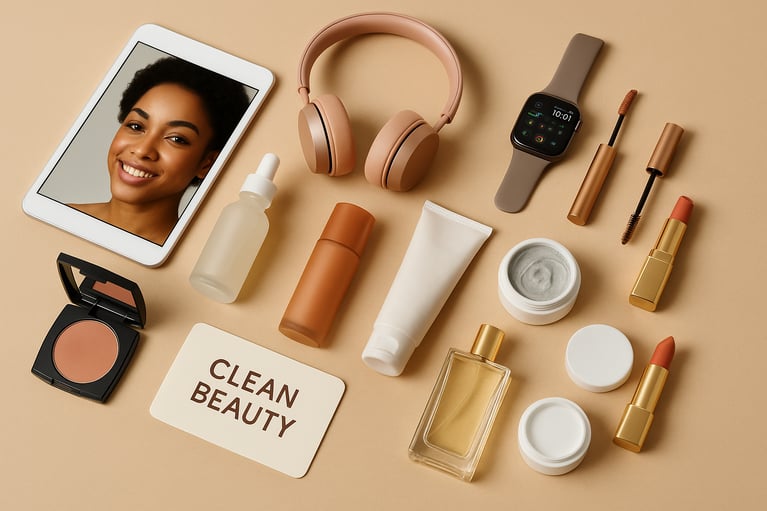As one of the most competitive ecommerce categories, skincare offers high rewards to brands that get it right. The demand is there. Skincare is projected to hit $220.75 billion by 2029, and consumers aren’t slowing down.
What’s driving this growth? A combination of ingredient transparency, social proof and personalization. Consumers are looking beyond flashy claims. They want to know what’s in the bottle, how it works and whether it’s right for their specific needs. This creates meaningful opportunities for ecommerce brands that can deliver on both substance and story.
As established players dominate the market and new brands enter every day, differentiation is the biggest challenge, not demand.
This playbook breaks down exactly how to stand out, scale up and win long-term without relying on hype or guesswork.
Build a strong brand foundation
Your brand is your north star as it influences every interaction, product decision and marketing message. Without a clear identity, it’s easy to get lost in a crowded category.
A. Define your brand identity and unique selling point
In skincare ecommerce, your brand goes far beyond visual identity. It's the promise you make to customers and the reason they choose you over competitors. This includes what your product does, who it’s for and why it’s better.
Don't make vague claims like "the world's best skincare." Instead, be specific about what you solve. For example, "clinically proven to reduce redness in 10 days" is much stronger than generic quality promises.
Make your messaging benefits-led and customer-centric in every customer touchpoint, from product descriptions to social media content. Consider what makes your approach unique: Is it your innovative ingredients, sustainable sourcing, specific skin type focus or unique product format?
B. Know your audience inside and out
Growth starts with understanding exactly who you're selling to. Your audience isn’t “everyone with skin” — it's a mix of tightly defined segments, from Gen Z acne sufferers to perimenopausal women to men exploring skincare for the first time.
To really understand your audience, spend time in skincare communities on Reddit, Facebook groups and forums. This is where people share their real problems and talk about what they actually want from skincare products.
Pay attention to what your customers value. Today's buyers care about clean ingredients, sustainability and brands that match their values. They're also willing to pay more for products that deliver real results.
Additionally, recognize the difference between one-time buyers and potential subscribers. Each group requires different marketing and retention strategies.
C. Conduct competitor and market research
Look at what other brands are doing well and where they're missing the mark. This helps you find gaps in the market and opportunities to position your brand differently.
Focus on underserved niches. For example, products for fungal acne or extremely sensitive skin often have less competition than general anti-aging products.
Stay on top of trends by following skincare publications and communities. Movements like "clean beauty" and minimalist routines create new opportunities for smart brands.
Create products people actually want
Once your brand foundation is solid, your product experience must follow through. The product itself can be your strongest acquisition and retention tool when it comes to a category driven by efficacy, credibility and feel.
A. Build quality products
Quality is everything in skincare. Use Good Manufacturing Practices (GMP) to make sure your products are safe and consistent. This includes working with reliable suppliers, maintaining strict quality control, and following all safety regulations.
Choose reliable suppliers who can demonstrate their quality standards, certifications and regulatory compliance. Your supplier relationships directly impact product quality, so invest time in finding partners who share your commitment to excellence.
B. Create product pages that drive confidence and sales
The biggest fear skincare buyers have is "Will this work for me?" Your product pages need to answer this question with detailed information and proof.
Be transparent about ingredients. List them clearly, explain their benefits, and identify potential allergens. Share information about where you source ingredients and your sustainability practices. Consider using visual indicators like icons for quick scanning (vegan, fragrance-free, paraben-free).
Plus, use sensory details about texture, scent and application to help customers visualize the experience of using your product.
Use social proof. Include before-and-after photos, customer reviews and testimonials prominently. Add media mentions, awards or expert endorsements to build credibility.
C. Personalize the experience at every touchpoint
Skincare is intimate; consumers apply it to their face daily. Create quizzes that help customers identify their skin type and find the right products for their needs. This could also give you valuable data about your customers.
Create "My Skincare Profile" sections for returning customers. This stores their preferences, purchase history, and skin concerns. Use this data to provide personalized product recommendations and targeted messages.
Harness technology to personalize even more. Virtual product testing through AR technology allows customers to visualize products on their skin, while AI-powered recommendation engines can suggest products based on skin type, concerns and purchase history.
Get found online
Even the best skincare products won’t sell if your audience can’t find them. Organic discovery through search and content builds long-term equity.
A. Become a trusted skincare resource
Skincare is one of the most searched beauty categories. Use SEO-focused content to become a go-to source.
To do this, focus on specific search terms like "best skincare routine for humid weather" rather than broad terms like "skincare." These specific searches often have less competition and attract people ready to buy.
Additionally, create helpful content that shows you know skincare. Write guides about routines, ingredients and skin types. Answer real questions from skincare forums and communities.
Educational content builds trust and helps with search engine rankings. When customers see you as a trusted source of skincare knowledge, they're more likely to buy from you.
B. Distribute and repurpose across channels
Great content needs to reach the right people. Share your content across multiple platforms, but adapt it for each platform's style and audience.
- Instagram, Pinterest, and YouTube for visual tutorials
- TikTok for bite-sized skincare education
- Newsletters and SMS for direct engagement
Also, build seasonal content calendars that reflect consumer behavior (e.g., “Summer Skincare Survival Guide” or “Winter Barrier Boosters”).
Make your content shareable by including practical tips, surprising insights or visually appealing elements that people want to share with friends.
Acquire new customers through influence and community
Skincare buyers trust people, not ads. And that’s where community-driven strategies shine.
A. Partner with micro-influencers
Choose influencers carefully. Micro-influencers with smaller but highly engaged audiences often deliver better results than celebrities with millions of followers.
Build long-term relationships instead of one-off posts. When influencers use your products over time, their reviews feel more authentic and trustworthy.
Set clear expectations with contracts that outline content guidelines, posting schedules and performance metrics. Make sure all content aligns with your brand voice and values.
B. Build a community on social media
UGC (user-generated content) builds social proof and encourages word-of-mouth. Encourage customers to share their results using your branded hashtags. Before-and-after photos and real customer stories provide powerful social proof that influences potential buyers more than traditional advertising.
Don’t forget to engage with your community. Respond to comments and share their content to build genuine relationships with your customers.
C. Master personalized email marketing
Email remains one of the highest return of investment (ROI) ecommerce channels but only when it’s done right. Create different email lists based on customer behavior, purchase history and skin concerns.
Set up automated email sequences including welcome series for new subscribers, replenishment reminders for regular products and cart recovery campaigns.
Use location and weather data for personalized emails. Customers in humid climates might get different product recommendations than those in dry areas.
Turn customers into loyal advocates
Acquisition is only half the equation; sustainable growth comes from repeat purchases and high lifetime value (LTV).
A. Launch flexible subscription models
Replenishment is a natural fit for daily-use skincare items. Offer "subscribe and save" options for daily products like cleansers and moisturizers with meaningful discounts.
Make subscription management easy with customer portals where people can adjust delivery schedules, pause subscriptions or change their orders.
Keep subscribers engaged with exclusive content, early access to new products and personalized skincare tips.
B. Build loyalty through exclusivity
Develop VIP programs that make your best customers feel special. Offer early access to new products, limited edition items or exclusive educational content.
Create tiered loyalty programs that reward customers for continued purchases and engagement. Benefits might include discounts, free shipping, birthday gifts or access to expert consultations.
C. Price strategically
Position premium products appropriately for customers who value quality and exclusivity. These customers often prefer higher-priced products as they associate cost with effectiveness and quality.
Plan sales and promotions around seasonal needs, product launches or inventory management. Balance profitability with strategic discounting to avoid brand erosion.
Monitor competitor pricing and adjust your strategy based on market conditions and seasonal demand.
Build trust through transparency and authenticity
Trust is your most powerful asset and hardest to win back. That trust is built over time through consistency, transparency and proof.
A. Be environmentally responsible
Consumers are savvy and vocal about greenwashing. Be transparent and evidence-backed in your claims.
Use eco-friendly packaging that actually works for your products while minimizing environmental impact. This might include recyclable materials or refillable options.
Share detailed information about your sustainability practices. Many consumers will pay more for products that align with their environmental values.
B. Earn credibility through real validation
Pursue third-party certifications and awards that validate your product quality and brand credibility. Industry recognitions provide external validation that influences customer perception and purchase decisions.
Build relationships with beauty magazines, skincare publications and industry influencers. Media coverage and expert endorsements significantly boost brand credibility and awareness.
Make customer reviews easily accessible and trustworthy. Implement review systems that prevent fake reviews while encouraging honest feedback. Respond to both positive and negative reviews professionally to demonstrate customer service commitment.
Expand your reach and stay ahead of trends
Scaling means thinking beyond D2C. Consider the following for your brand expansion.
A. Create offline brand moments
Despite being an ecommerce brand, physical experiences can create stronger emotional connections, especially in skincare. Consider pop-up shops, trade show participation or partnerships with select retailers.
In-person events let customers touch, test and experience your products firsthand. These interactions often lead to higher conversion rates and stronger brand loyalty.
Participate in industry trade shows and beauty events to network with potential partners and showcase your products to new audiences.
B. Stay ahead of trends
Stay tuned into what matters most to your consumers. Trends like "clean beauty" and minimalist routines create opportunities for new products and marketing approaches.
Follow industry publications and engage with professional skincare communities to understand emerging ingredients and consumer preferences before they become mainstream.
Use trend insights to inform product development, content creation and marketing strategies. Growth-minded skincare brands evolve with their customers, not just their competitors.
Ready to grow your skincare brand?
Cart.com’s growth marketing team knows the ins and outs of beauty ecommerce and can work with you to bring your vision to life, step by step. Talk to our team today.
Subscribe to our emails for the latest industry insights!
By entering your email, you agree to receive marketing emails from Cart.com





